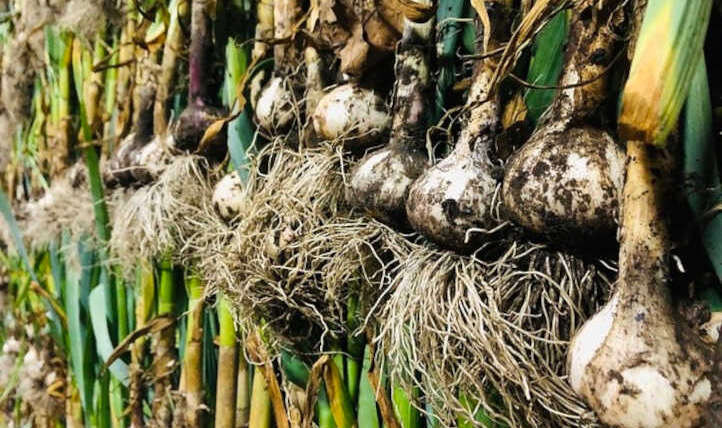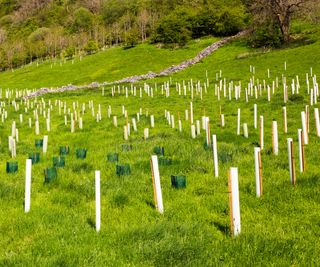If you want to improve the soil health of your garden and reuse your kitchen and garden waste in an environmentally friendly way, composting is a no-brainer. Unfortunately, despite the many benefits, gardeners often overlook this wonderful practice due to a few insidious myths that make it seem like it is not worthwhile.
From bad smells to complicated recipes, there are many misconceptions about composting. Some have some truth to them, but understanding the real facts will help you dispel the fiction and get started on your soil enrichment journey.
Myth 1: Compost Smells Bad
Compost piles are often assumed to smell bad, but they can have a pleasant earthy scent with proper management.
Given that compost piles contain a bunch of leftover kitchen and garden waste, it makes sense that many people assume compost always smells bad.
This is the number one reason I hear from new gardeners when asked why they avoid composting – especially for those gardening in small spaces. If you only have a few square feet of space to use, you understandably don’t want part of it to be taken up by foul-smelling compost.
But if you manage your pile correctly, including the right ingredients and ratios, the compost shouldn’t smell bad at all. In fact, it should actually smell quite good if you’re a fan of earthy gardening scents.
There are many composting myths that gardeners believe without questioning the logic behind them.
Reasons Your Compost Might Smell Bad
Smelly compost is a sign that something is going wrong with your pile. Luckily, these mistakes can easily be resolved or avoided to ensure a healthy and productive composting experience.
The Pile Is Compacted
 Improperly built compost piles lack oxygen, leading to anaerobic decomposition that releases unpleasant smells.
Improperly built compost piles lack oxygen, leading to anaerobic decomposition that releases unpleasant smells.
If you’ve built your pile incorrectly and it becomes dense and compacted, it probably lacks oxygen in some areas. Oxygen is required for aerobic decomposition (literally meaning ‘with air’) as the organisms that break down the compost need oxygen to survive.
Without oxygen, decomposing materials become anaerobic. As it breaks down – much slower than aerobic compost does – it releases methane that quickly fills your garden with a very unpleasant smell. Anaerobic compost also doesn’t generate as much heat, taking a long time to break down and potentially spreading plant diseases and weeds around your garden.
To resolve the problem, it’s best to rebuild the pile and keep it light and airy to allow oxygen to flow. Turning your compost pile regularly will also keep it properly aerated.
It Contains Too Much Green Material
 Properly balancing the ratio of the green and brown materials in your pile is crucial to prevent unpleasant odors.
Properly balancing the ratio of the green and brown materials in your pile is crucial to prevent unpleasant odors.
When composting, you need to consider your ratio of green material (grass clippings, spent plants) to brown material (branches, dried leaves) for the pile to break down successfully. If you have too much green waste, your pile can start to smell as it breaks down.
Too much green material is more common than too much brown. I’ve made this mistake when composting grass after mowing the lawn, forgetting to supplement it with brown materials from the garden too.
Again, rebuilding is the best way to resolve the problem, ensuring you keep a closer eye on your green-to-brown ratios by volume. Turning the pile will help here, but it’s better to ensure you have ample brown materials from the start.
The Pile Is Too Wet
 Manage moisture in composting to prevent bad smells and slow decomposition.
Manage moisture in composting to prevent bad smells and slow decomposition.
Moisture is another composting factor you need to manage to avoid bad scents. Soggy compost not only breaks down slower, but the excess moisture also limits the movement of oxygen.
This can suffocate the essential microorganisms needed to break down the compost successfully, leading to the same issues as problem one.
Even if the compost isn’t visibly soggy, lack of decomposition, flies, lack of heat, and the unpleasant smell indicates that there may be too much moisture. Keep your pile protected from too much rainy weather, and avoid using too many greens, which can also contribute to increased moisture levels.
You’ve Added Fats, Oils, or Meats
 To prevent bad odors, avoid including fats, oils, and meats in aerobic hot composting piles.
To prevent bad odors, avoid including fats, oils, and meats in aerobic hot composting piles.
A few waste products are best avoided to prevent bad smells when building an aerobic hot composting pile. Any kitchen waste that includes fats, oils, or meats falls under this category, as they will start to smell when they rot and break down.
That doesn’t mean you can’t compost this waste at all. The Bokashi composting method is great for breaking down any other items you wouldn’t throw in your hot compost pile and keeps the smells contained inside a sealed container.
Myth 2: Compost Attracts Pests
 Composting may attract bugs and rodents, but beneficial insects aid in decomposition.
Composting may attract bugs and rodents, but beneficial insects aid in decomposition.
Bad bugs and rodents are not things many gardeners want to attract to their backyard. If you’re particularly squeamish, you may hold off on composting to avoid inviting any unwanted critters around your garden beds.
There is some truth to the claim that compost attracts bugs, but it’s important to remember that not all bugs are bad. Insects are vital to your garden’s biodiversity, particularly when composting, as some of the larger bugs help accelerate the decomposition process.
An active pile is a sign that your waste is breaking down successfully. These bugs will largely remain on the visible outer edges where it is cooler rather than in the center of the heat generation.
You can close off the bin to limit access, but it’s often better for the health of your garden to let it house a couple of beneficial insects.
Compost can also attract rodents, depending on what you add to the pile. The easiest way to avoid this is to keep materials in an enclosed container like a compost tumbler, preventing any neighborhood wildlife from getting in.
Myth 3: Composting Is Complicated
 Simple composting involves combining green and brown materials in a bin for effective results.
Simple composting involves combining green and brown materials in a bin for effective results.
If you look at any in-depth composting guide online, you’ll notice that the process can get quite technical. From managing nutrient ratios to maintaining consistent temperatures and working out the perfect recipe of ingredients, it can all seem too complicated to be worthwhile.
But, like most things in gardening, it doesn’t have to be too technical. If you’re interested in the process and want to get down to the nitty-gritty, you do have that option, and your pile will likely be more effective if you do. But if you aren’t into the science behind it and want to limit time invested in the process, you can stick to the basics.
Rather than following any complex recipes or worrying about what your compost contains, start off with a simple combination of equal parts green and brown materials tossed in a storebought or DIY compost bin. Once added, you can forget about the pile and wait for everything to break down.
Even if you don’t set up data-packed spreadsheets and monitor decomposition vigorously, simply adding your garden waste to a single pile still counts as composting. And it’s a far better use of your garden waste than sending it away.
Myth 4: Composting Takes A Long Time
 Composting takes time, but the proper management of your pile will provide a continuous supply of organic material.
Composting takes time, but the proper management of your pile will provide a continuous supply of organic material.
For impatient gardeners (myself included), it’s easy to dismiss composting on the grounds that it takes too long to deliver results. Why wait months or years for a final product when you can head to a nursery and buy a bag in an afternoon?
Depending on how you manage your pile, it can take a while before the compost is ready to use in the garden. But once you get started, it’s the best way to have a continuous supply of healthy organic material without dipping into your gardening budget. The initial time investment will allow you to boost your soil health at no extra cost, which is especially beneficial if you have a large garden. Plus, you’re reusing waste that would otherwise be useless.
But if you’re willing to do a little work, composting doesn’t have to take long at all. In fact, you can have usable compost in as little as 18 days using the Berkeley method. Developed by the University of California, this hot composting method turns garden waste into rich, broken-down compost in less than three weeks.
This method does involve managing a carbon-to-nitrogen ratio of around 30:1 (alternatively, add equal parts greens and browns by volume), maintaining high temperatures around 140F, and turning every second day after the first four days. You can use this compost thermometer to monitor temperatures inside your pile accurately.
If you’re happy to wait a little longer, even basic management and maintenance (particularly when it comes to temperatures) will deliver results far quicker than a cold pile that takes up to a year to break down.
Myth 5: Compost Kills All Weed Seeds
 Hot composting can kill weed seeds if you can maintain the right high temperatures.
Hot composting can kill weed seeds if you can maintain the right high temperatures.
One of the major benefits of hot composting is that it can kill weed seeds, allowing you to discard any garden waste without fear of spreading those weeds around your garden beds. But this is not a foolproof process, and managing the pile correctly is important if you want to reap these benefits.
To kill weed seeds, your compost must heat up to at least 140F for several days. The weed seeds you’re trying to kill must also be exposed to these temperatures in the center of the pile and not left on the edges where it is much cooler.
If you manage your compost well and turn it regularly, it can effectively kill off the seeds. But to be safe, it’s best to trim the weeds before they go to seed and allow them to dry out completely in the sun before adding them to your compost pile. You can also use your weeds around the garden in beneficial ways, such as making fertilizer.
Final Thoughts
Don’t let any of these myths stop you from composting. Whether you have a small garden or an expansive backyard, there are ways to compost that suit your garden needs and goals.




